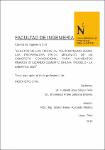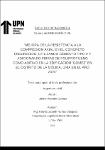Mostrar el registro sencillo del ítem
Influencia de la incorporación de fibra de polipropileno monofilamento en la resistencia mecánica del concreto de f’c=210 kg/cm2
| dc.contributor.advisor | Mosqueira Moreno, Miguel Ángel | |
| dc.contributor.author | Salcedo Espinoza, Wilder Omar | |
| dc.date.accessioned | 2017-11-09T13:49:52Z | |
| dc.date.available | 2017-11-09T13:49:52Z | |
| dc.date.issued | 2017-05-29 | |
| dc.identifier.citation | Salcedo, W. O. (2016). Influencia de la incorporación de fibra de polipropileno monofilamento en la resistencia mecánica del concreto de f’c=210 kg/cm2 (Tesis de licenciatura). Repositorio de la Universidad Privada del Norte. Recuperado de http://hdl.handle.net/11537/11324 | es_PE |
| dc.identifier.other | 624 SALC 2016 | es_PE |
| dc.identifier.uri | https://hdl.handle.net/11537/11324 | |
| dc.description.abstract | RESUMEN En la presente investigación se ha evaluado la influencia que tiene la incorporación de fibra de polipropileno monofilamento en la resistencia mecánica del concreto de f´c = 210 kg/cm2. La evaluación consistió en determinar y comparar los resultados de los ensayos a compresión y flexión de un concreto sin incorporación de fibra de polipropileno monofilamento (concreto patrón), con otros concretos con incorporación de 0.2, 0.4, 0.6 y 0.8% de fibra de polipropileno monofilamento, que en peso seria 2, 4, 6 y 8 kg/m3 de fibra respectivamente. El concreto sin incorporación de fibra (concreto patrón) y los concretos con incorporación de fibra, han sido elaborados con agregados provenientes de la cantera del río Chonta (Planta de Chancado “Roca Fuerte”), de tamaño máximo nominal del agregado grueso de 3/4”, cemento Pacasmayo Tipo I, fibra sintética de polipropileno monofilamento del tipo SikaFiber FORCE PP – 48 y agua. El diseño de mezclas se realizó con el método del Comité 211 del ACI. Lo realizado contempla, ensayos para determinar las propiedades físicas y mecánicas de los agregados (grueso y fino), ensayos al concreto en estado fresco y endurecido; siendo los más importantes el ensayo de resistencia a compresión axial y flexión del concreto. En base a los resultados, se obtuvo que al incorporar fibra de polipropileno monofilamento al concreto en 0.4%, esta incrementa en 5.84% la resistencia a la compresión y en 17.20% la resistencia a la flexión del concreto con respecto al concreto patrón. El incremento de la resistencia a la compresión de 5.84% representa una resistencia a la compresión axial promedio f´c = 234.50 kg/cm2, y el incremento de la resistencia a la flexión de 17.20% representa una resistencia a la flexión promedio Mr = 37.36 kg/cm2. | es_PE |
| dc.description.abstract | ABSTRACT In the present investigation, it has been evaluated the influence of the incorporation of polypropylene monofilament fiber in the mechanical strength of concrete of f'c = 210 kg/cm2. The evaluation consisted in determining and comparing the results of the compression and bending tests of a concrete without incorporation of polypropylene monofilament fiber (standard concrete), with other concretes incorporating 0.2, 0.4, 0.6 and 0.8% polypropylene monofilament fiber, which by weight would be 2, 4, 6 and 8 kg/m3 of fiber respectively. The concrete without fiber incorporation (concrete standard) and the concretes with fiber incorporation have been elaborated with aggregates from the Chonta River Quarr ("Roca Fuerte" Crusher Plant), with maximum nominal size of the aggregate thickness of 3/4", cement Pacasmayo Type I, synthetic fiber of polypropylene monofilament tipe SikaFiber FORCE PP - 48 and water. The design of mixtures was done using the ACI Committee 211 method. The work carried out contemplates, tests to determine the physical and mechanical properties of the aggregates (coarse and fine), tests on concrete in a fresh and hardened condition; the most important being the axial compression and bending test of concrete. Based on the results, it was obtained that by incorporating monofilament polypropylene fiber to the concrete in 0.4%, this increases in 5.84% the compressive strength and in 17.20% the flexural strength of the concrete with respect to the standard concrete. The increase in the compressive strength of 5.84% represents an average axial compressive strength f'c = 234.50 kg/cm2, and the increase in the bending strength of 17.20% represents an average flexural strength Mr = 37.36 Kg/cm2. | es_PE |
| dc.description.uri | Tesis | es_PE |
| dc.format | application/pdf | es_PE |
| dc.language.iso | spa | es_PE |
| dc.publisher | Universidad Privada del Norte | es_PE |
| dc.rights | info:eu-repo/semantics/closedAccess | es_PE |
| dc.source | Universidad Privada del Norte | es_PE |
| dc.source | Repositorio Institucional - UPN | es_PE |
| dc.subject | Resistencia a la compresión | es_PE |
| dc.subject | Concreto | es_PE |
| dc.subject | Materiales | es_PE |
| dc.subject | Resistencia de materiales | es_PE |
| dc.title | Influencia de la incorporación de fibra de polipropileno monofilamento en la resistencia mecánica del concreto de f’c=210 kg/cm2 | es_PE |
| dc.type | info:eu-repo/semantics/bachelorThesis | es_PE |
| thesis.degree.grantor | Universidad Privada del Norte. Facultad de Ingeniería | es_PE |
| thesis.degree.level | Título Profesional | es_PE |
| thesis.degree.discipline | Ingeniería Civil | es_PE |
| thesis.degree.name | Ingeniero Civil | es_PE |
| dc.publisher.country | PE | es_PE |
| dc.subject.ocde | https://purl.org/pe-repo/ocde/ford#2.01.01 | es_PE |
| thesis.degree.program | Pregrado | es_PE |
| dc.description.sede | Cajamarca | es_PE |
| renati.advisor.dni | 26733060 | |
| renati.author.dni | 45376110 | |
| renati.discipline | 732016 | es_PE |
| renati.level | https://purl.org/pe-repo/renati/level#tituloProfesional | es_PE |
| renati.type | https://purl.org/pe-repo/renati/type#tesis | es_PE |
Ficheros en el ítem
Este ítem aparece en la(s) siguiente(s) colección(ones)
-
Tesis [1798]





